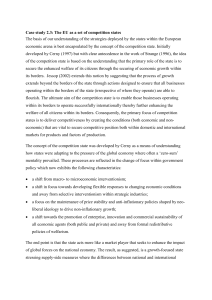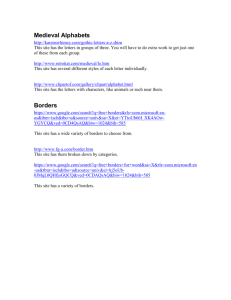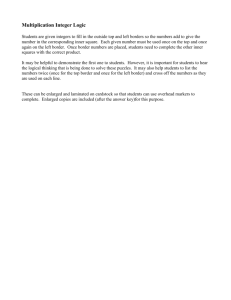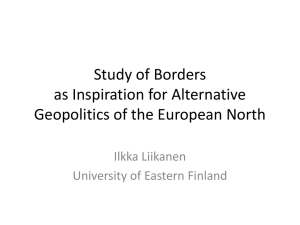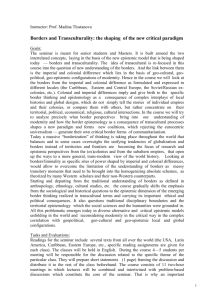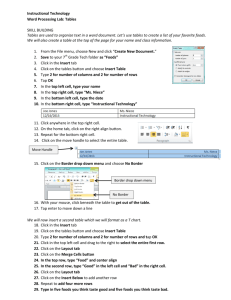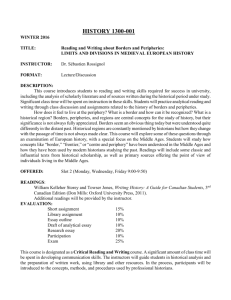The Nature of Borders and Conflict
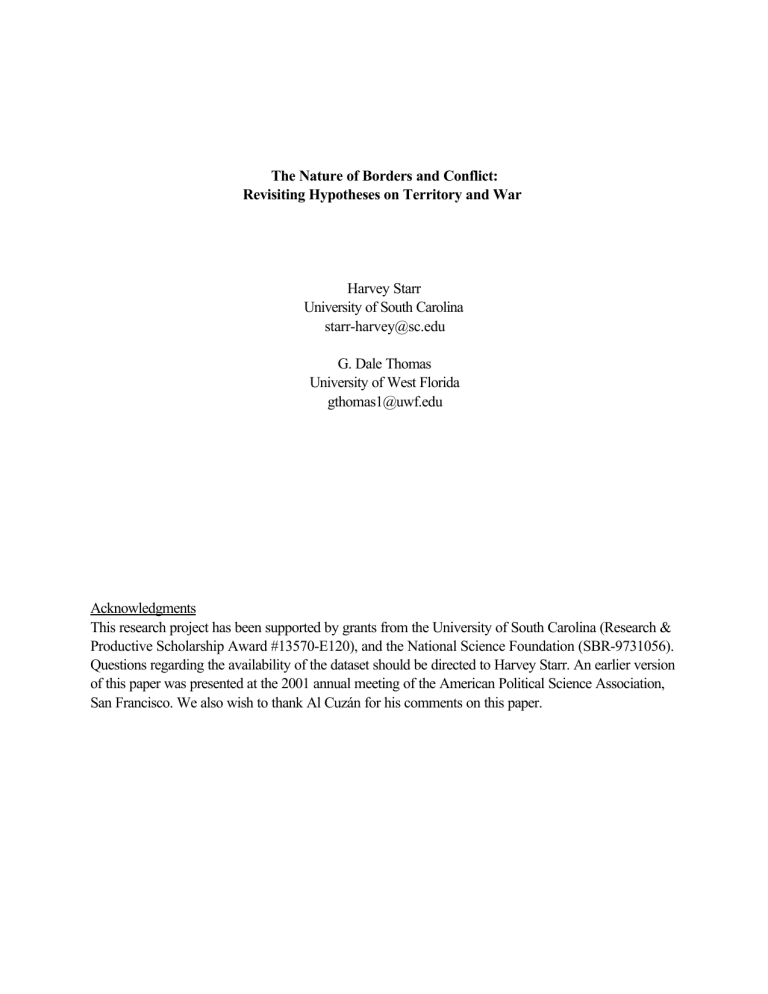
The Nature of Borders and Conflict:
Revisiting Hypotheses on Territory and War
Harvey Starr
University of South Carolina starr-harvey@sc.edu
G. Dale Thomas
University of West Florida gthomas1@uwf.edu
Acknowledgments
This research project has been supported by grants from the University of South Carolina (Research &
Productive Scholarship Award #13570-E120), and the National Science Foundation (SBR-9731056).
Questions regarding the availability of the dataset should be directed to Harvey Starr. An earlier version of this paper was presented at the 2001 annual meeting of the American Political Science Association,
San Francisco. We also wish to thank Al Cuzán for his comments on this paper.
ABSTRACT
This study examines the utility of moving beyond a simple “on-off” dichotomous view of contiguous land borders. For each of the 301 contiguous land borders between states in the international system, measures of ease of interaction, salience, and overall border vitalness have been developed using
Geographical Information Systems technology. These variables are used to test two major extant lines of thought in international relations literature, as well as our proposed alternative, regarding the expected effect of the “nature” of borders on interstate behavior. We conclude not only that the
“nature” of contiguous borders matters but also that the relationship between each of the three border measures and the likelihood of conflict is curvilinear concave– with both high ease of interaction and high salience related to lower levels of conflict, and the middle range of both variables related to higher levels of conflict.
THE NATURE OF BORDERS AND CONFLICT
The location of states, their proximity to one another, and especially whether or not they share
"borders," emerge time and again as key variables in studies of international conflict phenomena: from major power general war, to the diffusion of international conflict, to the analysis of peace between pairs of democracies (see, for example, the recent survey by Hensel 2000). From Boulding's (1962) ideas of "behavior space," "loss-of-strength gradient" and "critical boundary" to the simple but profound concern of geographers that humans interact most with those to whom they are closest, there are powerful theoretical reasons to be interested in borders, and how they affect international relations.
Clearly, a key dimension for many researchers is proximity (see for example, Gochman's 1992 discussion of borders as they relate to the overall COW project). The diffusion research of Most and
Starr (e.g., 1980) moved to the study of borders after concluding that the diffusion of certain phenomena could only be studied by looking at units that were "relevant" to one another-- and that such relevance could be indicated by geographical proximity (see also the work of Lemke-- 1995, 1996).
1
Proximity, in turn, could be operationalized through "borders." Borders were seen as important indicators of proximity because they were strongly related to both the opportunity and willingness of state actors as conceptualized by Starr and Most (1976). One key aspect of borders is that they affect the interaction opportunities of states, constraining or expanding the possibilities of interaction that are available to them. States that share borders will tend to have a greater ease of interaction with one another, and thus will tend to have greater numbers of interactions. This idea developed from multidisciplinary sources, such as economist Kenneth Boulding's (1962) concept of the loss-of-strength gradient; or geographer G.K. Zipf's (1949) "law of least effort." The important issue raised here is that
1
borders create the opportunity for interaction (see Starr and Most 1976 and 1989, and Siverson and
Starr 1991 for a full discussion of geographic opportunity).
Such opportunity might be seen in terms of the number of other countries with which any single state has interaction opportunities. It might also be seen in the degree to which such opportunity exists between any particular pair of states. So, for example, Wesley (1962) argues that the length of a common border between two countries is a better measure of "geographic opportunity" than simply the number of borders. One of the authors has argued elsewhere that the opportunities for interaction view of borders gets at the important conceptual core of proximity in a way that other measures of "distance" do not.
Secondly, borders also have an impact on the willingness of decision makers to choose certain policy options, in that they act as indicators of areas of great importance or salience . Because other states are close, having greater ease of interaction and the ability to bring military capabilities to bear, these neighbors are also key areas of external cues (or diffusion). Accordingly, activities in these areas are particularly worrisome, can create uncertainty, and thus deserve attention. The notion that changes in bordering areas create uncertainty because of their proximity is based on arguments developed by
Midlarsky (e.g., 1970, 1975), and applied in Most and Starr (1980). Starr and Most (1976, 10) are also particularly concerned with the "roles that different types of borders appear to play" in war involvement. Different types of borders might have differential impacts on both opportunity and willingness. Thus, borders are differentiated in terms of homeland borders and borders generated by colonial territories. This differentiation allows analysts to test whether all territory is seen as equally important, or whether homeland territory generates greater willingness than more distantly held
2
colonial/imperial territories. Implicitly tested in such analyses is the notion that it is homeland territory per se , that is important: that the proximity of any homeland territory of one state to any homeland territory of another state is the important factor
Part of the considerable research devoted to borders and territory suggests that territorial contiguity is a major determinant of whether or not a state will go to war with another state. Indeed, as a significant piece of the war puzzle, Vasquez suggests that territorial contiguity is the “source of conflict most likely to result in war” (Vasquez 1993, 307). However, perhaps simple contiguity may not be the critical factor. Dropping one level of analysis lower, Vasquez (1993) also hypothesizes that the nature of the border between two states affects the probability that states will go to war. Specifically, he hypothesizes that borders that coincide with natural frontiers or that traverse uninhabited regions or are seen as having little value are much less likely to provoke wars than dissimilar borders and border areas
(this is a theme picked up later by Lemke).
Nonetheless, arguments can be found in the literature to suggest that just the opposite is true.
Highly permeable and salient borders may produce qualitatively distinct behavior. For example, the ease of interaction and salience of border areas in northwestern Europe has– based on Deutsch’s social communication model of integration– most likely contributed to the area moving from high levels of conflict to high levels of cooperation. Relations between states with highly permeable and salient borders have shown a tendency toward interdependence/integration, making military conflict less likely and agreement more likely. For Karl Deutsch, transaction flows were central to the process by which integration took place and security communities were formed. According to Deutsch, countries are
“clusters of population, united by grids of communication flows and transport systems, and separated
3
by thinly settled or nearly empty territories” (as cited in Dougherty and Pfaltzgraff 1990, 435). The
Deutschian study of how countries become integrated focuses on these transaction grids. Continuous communication and transaction linkages are presented by Deutsch as one of nine conditions for the creation of security communities.
Also citing Deutsch, Cobb and Elder (1970, 8) go straight to the essential relationship: “The third basic notion from communications theory is the idea that ‘transactions flow... establish[es] mutual relevance of actors. An actor with whom you have very much to do is relevant to you...’ Given this assumption, the level of interaction, or transaction, between the members of two social units may be taken as a behavioral measure of their mutual relevance.” They further observe (Cobb and Elder 1970,
24): “Deutsch ... finds that all successful security communities have a multiplicity of transaction channels performing a variety of common functions and purposes. Indeed, a high rate of transactional exchange within an area may mean that the community achieves a degree of integration...” The results of Cobb and Elder’s empirical study link the exchange of transactions to mutual relevance and then mutual relevance to greater levels of interstate collaboration.
For Russett (e.g. 1963), the mutual relevance of integration leading to a security community is represented by “responsiveness”– or, “... the probability that requests emanating from one state to the other will be met favorably” (Russett 1974, 329). In looking at integration defined as either responsiveness or security communities, Russett (1974, 335) finds that transactions describe integration, predict integration, make integration possible, and even cause integration.
Given the role of transactions in Deutschian models of integration, and their potential as indicators of growing interdependence and/or integration, then greater ease of interaction along a
4
border also generates opportunities for positive interaction as well as opportunities for conflict. It is the latter relationship that was central to the Most and Starr (1980) interaction opportunity model, measured simply by the presence or absence of a border.
Thus, two sets of specific testable hypotheses are extant in the literature regarding the impact of the “nature” of borders on conflict. These hypotheses can be phrased as
• the easier a border is to cross, the greater the likelihood that the border will be a
• dispute border–Vasquez; the more salient a border is, the greater the likelihood that the border will be a dispute
• border–Vasquez; the easier a border is to cross, the less likelihood that the border will be a dispute border–Deutsch; the more salient a border is, the less likelihood that the border will be a dispute • border–Deutsch.
Both sets of hypotheses push scholars to move beyond the simple “on-off” indicator of contiguity.
Nonetheless, both sets of hypotheses postulate mutually exclusive monotonic relationships.
The notion of cost curves underlies all four of the above mentioned hypotheses. These are shown in Figure 1. As the ease of interaction increases (opportunity), the costs of projecting a state’s power across a border decreases. Similarly, based on the logic found in Vasquez, the value of highly salient border areas makes the marginal cost (related to willingness) to an actor much lower when such territory is threatened, while, on the other hand, low border salience increases an actor’s marginal costs. Yet, based on the Deutschian perspective, ease of interaction and border salience are likely to
5
coincide with the development of integration effects. As states become increasingly integrated, the costs of a militarized interstate dispute between them increases as well.
[Figure 1 Here]
Complexity has become a turn of the century by-word, and the dynamics conditioned by the nature of borders are likely anything but simple. Clearly, the identification and analysis of relevant dyads and relevant neighborhoods are important steps forward in testing many extant theories.
Willingness is simply not enough; opportunity must also exist. Thus, Vasquez argues that natural frontiers and borders of regions seen as having little of importance are less likely to generate conflict–less opportunity and less willingness to fight. However based on Deutschian models, ease of interaction may generate both opportunities for conflict but also integration and therefore less willingness to fight. Interestingly and importantly, the intersection of the two cost curves represents the region with lowest cost for a militarized interstate dispute. On this basis, we propose that both the
Vasquez and Deutschian hypotheses are independently incomplete; however, the insights of the two can be combined in a potentially powerful explanatory model. Rather than the relationship between the
“nature” of borders and conflict being monotonic increasing or decreasing, we propose that the relationship is concave: the lowest levels of opportunity and border region salience should correspond to proportionally low incidences of conflict as should the highest levels of opportunity and border region salience, while the middle range of opportunity and salience should have proportionally the highest incidences of conflict. Thus, the analysis which follows tests each of these three rival hypotheses.
RECONCEPTUALIZING BORDERS
This paper continues a project that has applied the use of geographical information systems
6
(GIS) to the study of geopolitics (see, for example, Starr and Bain 1995, Starr 2001; 2002, Starr and
Thomas Forthcoming). Using the opportunity and willingness framework and its ideas concerning interaction opportunities, this project has attempted to reconceptualize borders by creating measures of ease of interaction (opportunity) and salience/importance (willingness).
The GIS project builds upon these two dimensions of borders as indicators of proximity, to revise and reconceptualize how borders may be seen and measured. The global dataset derived from the GIS analyses includes 151 states with land borders, which generate 301 separate contiguous land borders between states. Using GIS has permitted a much fuller and clearer specification of borders by allowing us to talk about the specific qualities of borders in terms of opportunity and willingness. The
GIS methodology, however, must be driven by theoretical considerations. Out of the hundreds of variables found in the 16 data layers of the ARC/INFO GIS (based on the 1992 Digital Chart of the
World), only a few have been selected for the creation of the two indexes of ease of interaction and salience. This selection has been made in terms of basic theoretical issues found in both the international relations and the geography literatures.
2
Regarding opportunity , the notion of ease of interaction derives from Boulding's (1962) concern with the "loss-of-strength gradient," and the ability to project conventional military power. Out of the welter of possible variables (and taking various technical/analytic constraints into account), three central factors for the movement of land-based military capability have been selected-- the existence of roads, railroads, and the steepness of terrain. Based on the work of Boulding, Bueno de Mesquita, and
Lemke, an index created from these three factors both reflects ease of interaction, and is applicable
(valid) across a large set of international dyadic boundaries. An index has been created which simply
7
notes the presence or absence of roads and railroads, and represents the hypsography or slope of terrain.
3 This creates a simple combined 1 to 4 index, with 4 representing the greatest ease of interaction, and 1 the most difficult areas to move across. While the GIS is also used to generate maps, which are an important medium for the visual presentation of results, more importantly analysts have a way to represent any border (or section of any border) by a value from 1 to 4: values that can be used in data analyses within the GIS, both with other GIS variables or any other data sets that are imported into the ARC/INFO GIS.
Both the maps and the dataset can be used to demonstrate that the ease of interaction can vary along any single border that a state might have with a contiguous neighbor, capturing the variation that might occur on a very long border. Any particular portion of a border can be thus be characterized as to its degree of permeability. Thus, we are able to go beyond the simple "on-off" characterization of contiguity; go beyond the simple idea that contiguity provides the possibility for interaction. While some parts of some borders would make interaction highly likely or possible, other parts would make it much less likely. We can make such judgments regardless of the length of a border, or the number of different borders that a state might have.
Willingness is represented by the salience dimension of borders. Salience is concerned with the importance or value of territory along or behind a border. Again, the question is how importance/value is to be measured. Here we must be concerned with indicators which would discriminate the level of value or concern over territory. Drawing once more on geographers, demographics are seen as important: the territory on which a state's population lives. This is operationalized by areas of population concentration. A capital city, the locus of governmental activity and the symbol of the state, should also
8
be used to indicate the importance of territory. Note that in selecting areas of population concentration and the seats of government we have captured all three of the central elements of the state found in the international relations literature: territory, population, and government. Other coverages provide the location of items that indicate the importance of an area. For instance, active civil and military airports are identified, as well as such items as: military camps, forts, oil wells and refineries, power plants of various kinds, water tanks, factories, industrial complexes, hospitals, telecommunications stations, etc.
The wide variety of items taken from the GIS are used because the substantive importance of any single type of installation can vary considerably across states. By identifying the location of key aspects of a state's transportation, communication, energy production, industrial, agricultural, and security infrastructures, we have items that tap "importance" in a manner generally relevant to all states.
The salience or importance of a border area is determined by places of population concentration, state capitals, airfields, and selected cultural features located within a 50,000 meter buffer of the region's borders. Capital cities are automatically coded with the highest value found in any of the units of analysis. Each feature identified has been given a value based on the number of other features that fell within 4 kilometers of it. These can then be mapped based on the value, showing where clusters arose. The maps provide graphics which represent the numbers of points that overlap within four kilometer ranges. Again, any area in a buffer around a border can be characterized by a value from 1 to 4, which can be utilized in data analyses. A four value scale has been created, again with 4 indicating areas of the greatest salience, 1 indicating those areas with the least. As with opportunity for interaction, this representation of the salience of borders permits us to differentiate whole borders, to differentiate portions of long borders, and to make sense as to why some borders
9
might be seen as more important than others; why changes or events across some borders might generate more uncertainty than occurrences across other borders.
Having generated indexes for ease of interaction and for salience, these have been combined into an index that indicates the existence of what has been called a vital border . Recall that Most and
Starr (1989) argue that opportunity and willingness are jointly necessary conditions for certain types of behavior, and that they are related to each other in complex ways. The core of the vital border concept is that an arc or a border segment may combine high or low values reflecting both opportunity and willingness. Again, scores of 4 indicate a high level of "vitalness" and with 1 indicating the lowest level for the combined indexes.
TESTING HYPOTHESES: CONFLICT AND THE “NATURE” OF BORDERS
Above we introduced two views of territorial proximity, contiguity, and interaction opportunity.
The dataset that has been generated from the ARC/INFO GIS– with operationalizations of opportunity and willingness as ease of interaction and salience– permits us to evaluate empirically the theoretical claims of the two seemingly distinct bodies of literature and hypotheses. Which finds the greatest support? Or, more interestingly can both be only partially true? In order to give both sets of hypotheses an equal opportunity and to allow for the possibility that both may be partially true, the border measures have been divided into three categories: borders falling in the lowest 20 percent of weighted measures for ease of interaction, salience, and vital; borders falling in the middle 60 percent of weighted measures for ease of interaction, salience, and vital; and borders falling in the highest 20 percent of weighted measures for ease of interaction, salience, and vital.
4
The expected outcomes based on each of the hypotheses are shown in Table 1. If the Vasquez
10
hypotheses hold, then one would expect to see the lowest levels of conflict for the lowest 20 percent of cases (measured as ease of interaction, salience, and vital), and the highest levels of conflict for the highest 20 percent of cases. If the Deutschian integration/interdependence hypotheses hold, then one would expect to see the highest levels of conflict for the lowest 20 percent of cases, and the lowest levels of conflict for the highest 20 percent of cases. Finally, if both hypotheses sets have partial merit, as we suggest, then one would likely see low levels of conflict for both the upper and lower 20 percent but relatively high levels for the middle 60 percent.
[Table 1 Here]
Analyses and Discussion
One major assumption of this project is that the border data generated (from the 1992 Digital
Chart of the World) can be usefully applied backward for 20 to 25 years and forward for at least a decade. In other words, we assume that the data retain validity as a rough surrogate for the ease of interaction and salience of areas for this time frame. Therefore, subsets of two conflict datasets have been selected for the analyses based on this time frame. Enduring rivalries found in Goertz and Diehl
(1993; 1995) that fall into the broad temporal band covered by the GIS data as well as Militarized
Interstate Disputes (MID) between 1981 and 1992 provide two different conflict data sets with which the hypotheses can be tested.
5
Use of the two different data sets allows one to more thoroughly probe the effects of borders on conflict. Although some overlap exists between the contiguous border conflict dyads identified by both data sets, on the whole, the two data sets are characterized by different types of behavior. The enduring rivalries found in the work of Goertz and Diehl (1993; 1995) represent stable patterns of
11
international conflict involving frequent violent clashes between the protagonists. Alternatively, cases taken from the MID data set represent every MID that takes place across a contiguous land border and has a some form of militarized action.
6 Since the focus of the study is the conditioning effect of the nature of contiguous borders on conflict, even though multiple MIDs may exist between the same two countries, the border is simply coded as having been a MID border. This results in 91 different MID and 22 enduring rivalry contiguous land borders. The enduring rivalry dyads allow us to examine frequent escalations to violence between the same parties, while the MID dyads allow us to look at conflict escalation more broadly.
Each of the 301 contiguous land borders has been coded as either being an enduring rivalry border (Yes) or as not being an enduring rivalry border (No). If the borders do not condition enduring rivalry behavior, then the distribution of enduring rivalry borders should be proportional to the distribution of borders as a whole. Specifically, if enduring rivalry behavior is statistically independent of the “nature” of contiguous land borders, then between four and five of the 22 enduring rivalry borders should be in the lowest and highest 20 percent of “vital” borders. Similarly, between four and five of the 22 enduring rivalry borders should fall into the categories of the 20 percent representing the most difficult borders to cross and the 20 percent representing the easiest borders to cross. The distribution of enduring rivalry borders across the categories representing border salience will be the same if, indeed, enduring rivalry behavior is statistically independent of border salience. The Crosstab results for enduring rivalry borders and “vital”, ease of interaction, and salience are shown in Tables 2,
3, and 4 respectively.
[Tables 2, 3, and 4 Here]
12
Regarding Most and Starr’s (1989) assertion that opportunity and willingness are jointly necessary conditions for certain types of behavior, the presence or absence of enduring rivalry borders appears to be affected by how vital borders are, as shown in Table 2. Of the 60 least vital contiguous land borders in the world, only two are enduring rivalry borders. Proportionally, this is less than half of what one would expect. Similarly, only one of the 60 most vital contiguous land borders in the world is an enduring rivalry border. The probability of seeing this distribution by chance is approximately p=.031. Thus, we are indeed led to believe that the “vitalness” of a border affects the likelihood that the border will become an enduring rivalry border. However, neither the Vasquez nor Deutschian hypotheses completely hold. The relationship depicted in Table 2 is the inverted U-shaped relationship that we hypothesized: the combination of constrained opportunity through limited ease of interaction and low salience does reduce the probability of a border becoming an enduring rivalry border, yet so does the combination of easy interaction and high border salience. The highest probability of a border becoming an enduring rivalry border lies in the middle region, where the apparent costs are lowest.
Turning to the individual effects of ease of interaction and border salience on the probability of a contiguous land border being an enduring rivalry border, we see the same dynamics exhibited. One can see in Table 3 that enduring rivalries are less likely than expected to take place across borders with measures of ease of interaction in either the lowest or highest 20 percent. The probability of seeing this distribution of cases by chance if the occurrence of enduring rivalries is independent of the ease of interacting across a border is p=.049. Thus, the occurrence of enduring rivalry does appear related to how easy a border is to cross, and the relationship depicted in Table 3 is again the hypothesized inverted U-shape. Although the relationship shown in Table 4 is slightly weaker–the probability of
13
seeing this distribution of cases by chance if the variables are statistically independent is p=.085–the deviations from the expected values match those predicted by the inverted U-shape hypothesis.
Therefore, the occurrence of enduring rivalries between parties with contiguous land borders does appear to be directly related to the “nature” of the shared border. Enduring rivalries show a statistical dependence on all three weighted measures of the “nature” of borders developed in the GIS project. Furthermore, the relationship appears to be more complicated than previously hypothesized.
Rather than finding a simple monotonic increasing or decreasing function in the data, we have found that the relationship is concave. The greatest likelihood of a border being an enduring rivalry border occurs in the middle ranges of “vitalness”, ease of interaction, and salience.
Although the occurrence of enduring rivalries between contiguous parties appears dependent upon the nature of their shared borders, the occurrence of other types of militarized interstate disputes between contiguous parties may still be independent of the “nature” of their shared borders.
Consequently, this possibility is explored in Tables 5, 6, and 7. In all three Tables as with enduring rivalry borders, if a contiguous land border sharing dyad has had an MID, the border is coded as
“Yes.” If not, then the border is coded as “No.” The categories for the lowest 20 percent, middle 60 percent, and highest 20 percent remain the same from the previous analyses.
[Tables 5, 6, and 7 Here]
For each of the three variables, the relationship between the nature of the border and militarized conflict behavior is even more pronounced than it was for enduring rivalries. However, unlike the results for enduring rivalries, the distribution of cases for the variable “vital” has the highest probability of occurring by chance, p=.023. Nonetheless, this probability remains sufficiently low that one can
14
confidently say that militarized interstate dispute behavior is conditioned by the “nature” of shared land borders. The remaining probabilities are p=.006 for ease of interaction and p=.013 for salience.
Once again, none of the three Tables reveals dynamics predicted either by Vasquez or the
Deutschian integration models. Rather, each of the three Tables show that MIDs exhibit behavior corresponding to the combination of the Vasquez hypotheses with the Deutschian integration hypotheses. All three Tables clearly reveal the hypothesized inverted U-shape relationship. For example, whereas the expected count of MID borders in the lowest 20 percent of “vital” borders is18.1, the actual count is 15. Similarly, this is the expected count of MID borders in the highest 20 percent of “vital” borders, while the actual count is only 11. The differences are more extreme for the remaining two variables.
Assuming the apparent relationships are not spurious, these results suggest a number of important points. First, governments appear less likely to act/react over low salience border areas.
These include borders that exhibit relatively low population concentrations and, compared to the length of the border, a dearth of infrastructure. Strong arguments have been presented by Vasquez, Goertz and Diehl (1992), and Huth (1996), among others, that it is territory per se which generates conflict and war, both as the issue over which war breaks out, and as a factor which increases the stakes of a war. These arguments are based on the proposition that it is territory-- any territory-- which creates an opportunity for conflict, which serves as the issue for war, and which makes the stakes worth fighting over. Such arguments are not supported by the inverted U-shaped findings presented here– especially by the level of conflict found for the lowest 20 percent in regard to salience.
Second, and quite interestingly, border length fails as a competing explanation for why
15
governments fail to act/react over low salience border areas: of the thirteen MID borders in the lowest
20 percent of salient borders, seven have above average length, while six have below average length.
Third, high border salience makes dispute escalation to military conflict unlikely. Governments rely on other means of resolving disputes with countries with which they share neighboring vital border areas.
Both of these conditions dampen the probability for escalation to military conflict.
Fourth, Lemke’s (1995) concern for relevant neighborhoods finds moderate support in that governments are less likely to turn to military action in the face of physical constraints on mobility. Low ease of interaction reduces the probability of a border becoming a MID border. Fifth, the surprisingly low probability of a high ease of interaction becoming a MID border suggests that as cross-border interaction becomes easier, transaction flows are also likely to increase thereby contributing to the creation of a security community. Although other explanations may exist, states appear much less likely to escalate a dispute to military action with neighboring states sharing porous borders.
Given that both ease of interaction and salience have the same effect on conflict behavior, it is not surprising that these relationships are found in analyzing vital borders. Mirroring the findings for ease of interaction and salience, governmental dispute behavior is affected by the degree of border
“vitalness.” Neighboring countries sharing less vital border areas likely receive less governmental attention, and fewer meaningful events are likely to occur along such borders, including conflict events.
Neighboring countries sharing border areas of high “vitalness” may be seeing an interdependence/integration effect kick in, and also experience lower levels of conflict. As with its two component parts, measures of vital borders falling in the middle ranges experience the highest levels of conflict.
16
CONCLUSION
Borders matter. Proximity remains an important conceptual variable in the study of major power general war, the diffusion of international conflict, and crisis behavior. Whether or not states share borders has been a principal means of operationalizing proximity. However, a shared contiguous land border may not adequately reflect the expected underlying dynamics. Two different views on the relationship between contiguity and conflict from the literature were presented– each view, however, represented a linear (positive or negative) relationship between them. We proposed a curvilinear relationship, with the low occurrence of conflict at both the lowest and highest levels of ease of interaction (opportunity) and salience (willingness). In finding support for our hypothesis we have made two significant contributions to our understanding of the political geography of conflict and cooperation.
We have examined and demonstrated the utility of moving beyond a simple “on-off” dichotomous view of contiguous land borders to examine the terrain and human activity along shared border areas.
7
Secondly, we have demonstrated that the relationship between borders/contiguity and conflict behavior is non-linear. Neither contribution could have been made using previously collected data on contiguity which simply noted whether or not two states shared a land border. These results could only be possible with the type of data provided by the GIS project on the nature of borders.
Such results provide evidence that scholars should be moving beyond the simple dichotomous
“on-off” view of contiguous land borders to look at the nature of shared land borders. Failure to look beyond the presence/absence of shared borders will lead to model misspecification and an overall loss of model power. A border is not a border is not a border. Territory, per se , does not automatically becomes a reason for conflict ( a la one traditional view of territory as the cause/stakes of conflict,
17
exemplified by Vasquez but also such scholars as Goertz and Diehl, e.g. 1992), nor does it automatically create greater opportunity for conflict ( a la Most and Starr, e.g. 1980). Some types of borders are dramatically less likely to lead to military conflict than others, some types are more likely to lead to cooperative activity, and scholars need to account for these differences. Additionally, such analyses need to take place within a broader research context in which space and spatiality play a larger role– one co-equal with that of time. Ease of interaction and salience represent not only opportunity and willingness but also variation across both time-space and cost-space. Our findings highlight the importance of incorporating spatial components into the theory and methodology of our research design.
18
NOTES
1. The geographic/proximity element is also central to the concept and use of “relevant dyads” in international relations analyses. See, for example, Lemke and Reed (2001) or Leeds and Davis (1999).
2. See Starr (2002) for a fuller discussion of the nature of GIS, the ARC/INFO system, and the technical aspects of how the indexes were created.
3. Hypsography has been coded into three categories based on slope as follows: 0-5 degrees, 5-20 degrees, and greater than 20 degrees.
4. Due to the clumping of cases together at the breakpoints for both salience and ease of interaction
(e.g., 24 borders have a weighted ease of interaction measure equal to three), the borders do not divide perfectly into the lowest 20 percent, middle 60 percent, and the highest 20 percent. An effort has been made to make the categories as close to this ideal as possible. Also, the choice of the size of each of the three categories is in part arbitrary. However, one can also examine the distribution of MID borders and non MID borders– one of the datasets we will be using-- for each category and evaluate the validity of any particular choice. If the distribution of MID and non MID borders in each category approximate one another, then the choice is likely valid. If on the other hand, either the MID or non
MID borders are clustered near a break points, then a different cut off point may be more appropriate.
This has been checked using a series of box plots for each of the categories and variables, the categories of lowest 20%, middle 60%, and highest 20% for ease of interaction, salience, and vital and appears to be a valid division for the MID borders. Since the MID borders represent the greater number of cases (91 versus 22), this division is used throughout the analyses.
19
5. Recent enduring rival dyads (Goertz and Diehl 1993; 1995) include Afghanistan–Pakistan,
Algeria–Morocco, Argentina–Chile, Cambodia–Thailand, China–India, China–Rusia, Congo–Zaire,
Egypt–Israel, Ethiopia–Somalia, Ethiopia–Sudan, Greece–Turkey, India–Pakistan, Iran–Iraq,
Iraq–Kuwait, Israel–Jordan, Israel–Syria, Jordan–Syria, Kenya–Uganda, Laos–Thailand,
Norway–Russia, North Korea–South Korea, Saudi Arabia-Yemen.
6. The analysis uses data from the 1996 version of the Militarized Interstate Dispute data. Specifically, the start year of the dispute had to be greater than 1980, and the highest action of the dispute had to be greater than the coded value of 1. A coded value of one on the highest action in the dispute–i.e., the most hostile action taken–means that no militarized action took place.
7. One aim of the GIS project was to go beyond contiguity as an “on/off” indicator, and look at the nature of the border, not simply its existence. The creation of the two indexes and the collection of this dataset was to be directed explicitly at the question of whether it was simply territory that affected conflict. The analyses presented here indicate that it is not simply territory. Although a powerful motivator and factor in human relations, when it comes to organized human conflict, territory alone should not be seen as adequate for our analyses.
20
REFERENCES
Boulding, Kenneth E. (1962) Conflict and Defense . New York: Harper & Row.
Cobb, Roger W., and Charles Elder (1970) International Community . New York: Holt, Rinehart and Winston.
Dougherty, James E., and Robert L. Pfaltzgraff (1990) Contending Theories of International
Relations, 3 rd ed. New York: Harper and Row.
Gochman, Charles S. (1992) "Interstate Metrics: Conceptualizing, Operationalizing and Measuring the
Geographic Proximity of States Since the Congress of Vienna." In The New Geopolitics , ed.
Michael D. Ward. Philadelphia: Gordon and Breach.
Goertz, Gary and Paul F. Diehl (1992) Territorial Changes and International Conflict . London:
Routledge.
Goertz, Gary and Paul F. Diehl (1993) "Enduring Rivalries: Theoretical Constructs and Empirical
Patterns." International Studies Quarterly 37 (2):147-171.
Goertz, Gary and Paul F. Diehl (1995) "Taking 'Enduring' Out of Enduring Rivalry: The Rivalry
Approach to war and Peace." International Interactions 21 (3):291-308.
Hensel, Paul R. (2000) “Territory: Theory and Evidence on Geography and Conflict.” In What Do We
Know About War?
ed. John A. Vasquez. Boulder: Rowman & Littlefield.
Huth, Paul K. (1996) Standing Your Ground: Territorial Disputes and International Conflict . Ann
Arbor: University of Michigan Press.
Leeds, Brett Ashley and David R. Davis (1999) “Beneath the Surface: Regime Type and International
Interaction, 1953-1978.” Journal of Peace Research 36 (1): 5-21.
21
Lemke, Douglas (1995) "The Tyranny of Distance: Redefining Relevant Dyads." International
Interactions 17 (1):113-126.
Lemke, Douglas (1996) "Why So Much Peace?: Interstate War in Africa." Presented at the Annual
Meeting of the American Political Science Association, San Francisco, CA.
Lemke, Douglas and William Reed (2001) “The Relevance of Politically Relevant Dyads.” Journal of
Conflict Resolution 45 (1): 126-144.
Midlarsky, Manus I. (1970) "Mathematical Models of Instability and a Theory of Diffusion."
International Studies Quarterly 14:60-84.
Midlarsky, Manus I. (1975) On War . New York: Free Press.
Most, Benjamin A. and Harvey Starr (1980) "Diffusion, Reinforcement, Geopolitics, and the Spread of
War." American Political Science Review 74 (December):932-946.
Most, Benjamin A. and Harvey Starr (1989) Inquiry, Logic and International Politics . Columbia,
SC: University of South Carolina Press.
Russett, Bruce M. (1963) Community and Contention: Britain and America in the Twentieth
Century.
Cambridge: MIT Press.
Russett, Bruce M. (1974) “Transactions, Community, and International Political Integration.” In
Power and Community in World Politics , ed. Bruce M. Russett. San Francisco W.H.
Freeman.
Siverson Randolph M. and Harvey Starr (1991) The Diffusion of War . Ann Arbor: University of
Michigan Press.
Starr, Harvey (2001) “Using Geographic Information Systems to Revisit Enduring Rivalries: The Case
22
of Israel.” Geopolitics 5 (1):37-56.
Starr, Harvey (2002) “Opportunity, Willingness and Geographic Information Systems:
Reconceptualizing Borders in International Relations.” Political Geography 21: 243-261.
Starr, Harvey and Will Bain (1995) "The Application of Geographic Information Systems (GIS) to
International Studies." International Studies Notes 20 (2):1-8.
Starr, Harvey and Benjamin A. Most (1976) "The Substance and Study of Borders in International
Relations Research." International Studies Quarterly 20 (December):581-620.
Starr, Harvey and G. Dale Thomas ( Forthcoming) “The ‘Nature’ of Contiguous Borders: Ease of
Interaction, Salience, and the Analysis of Crisis.” International Interactions.
Vasquez, John (1993) The War Puzzle . Cambridge: Cambridge University Press.
Wesley, James P. (1962) "Frequency of Wars and Geographical Opportunity." Journal of Conflict
Resolution 6 (4):387-389.
Zipf, G.K. (1949) Human Behavior and the Principle of Least Effort . Cambridge, MA: Addison-
Wesley.
23
Figure 1 : Contradictory Extant Hypotheses on the Nature of Borders and the Likelihood of Conflict
24
TABLE 1: Hypotheses on the Probability of Conflict Based on the Nature of Borders *
Border Ease of Interaction, Salience, and “Vitalness”
Low Medium High
Vasquez CONFLICT
CONFLICT
CONFLICT
Deutsch CONFLICT
CONFLICT
CONFLICT Starr and Thomas CONFLICT
* The increased likelihood of conflict is visually depicted by an increased font size
CONFLICT
CONFLICT
25
TABLE 2: Enduring Rivalries and Vital Contiguous Land Borders
“Vital” Borders in
Three Categories lowest 20% middle 60% highest 20%
Total Number of Borders
Count
Expected Count
% of Total
Count
Expected Count
% of Total
Count
Expected Count
% of Total
Count
% of Total
Goertz and Diehl Enduring Rivalry
Border
No Yes
58
55.6
19.3%
162
2
4.4
.7%
19
167.8
53.8%
59
13.2
6.3%
1
55.6
19.6%
279
92.7%
4.4
.3%
22
7.3%
P 2
=6.935, p=.031
Total
60
19.9%
181
60.1%
60
19.9%
301
100.0%
TABLE 3: Enduring Rivalries and Ease of Interaction Across Contiguous Land Borders
Ease of
Interaction in
Three Categories lowest 20% middle 60% highest 20%
Count
Expected Count
% of Total
Count
Expected Count
% of Total
Count
Expected Count
Goertz and Diehl Enduring Rivalry
Border
No Yes
58
55.6
19.3%
168
2
4.4
.7%
19
173.3
55.8%
53
50.1
13.7
6.3%
1
3.9
Total Number of Borders
% of Total
Count
% of Total
17.6%
279
92.7%
.3%
22
7.3%
P 2
=6.018, p=.049
Total
60
19.9%
187
62.1%
54
17.9%
301
100.0%
TABLE 4: Enduring Rivalries and the Salience of Contiguous Land Borders
Goertz and Diehl Enduring Rivalry
Border
No Yes
Border Salience in Three
Categories lowest 20% middle 60% highest 20%
Count
Expected Count
% of Total
Count
Expected Count
% of Total
Count
66
62.1
21.9%
157
161.3
52.2%
56
1
4.9
.3%
17
12.7
5.6%
4
Total Number of Borders
P 2
=4.938, p=.085
Expected Count
% of Total
Count
% of Total
55.6
18.6%
279
92.7%
4.4
1.3%
22
7.3%
Total
67
22.3%
174
57.8%
60
19.9%
301
100.0%
TABLE 5: Militarized Interstate Disputes and Vital Contiguous Land Borders
“Vital” Borders in
Three Categories lowest 20% middle 60% highest 20%
Total Number of Borders
P 2 =7.574, p=.023
Count
Expected Count
% of Total
Count
Expected Count
% of Total
Count
Expected Count
% of Total
Count
% of Total
Border of a Dispute with Militarized
Action
No Yes
45
41.9
15.0%
116
15
18.1
5.0%
65
126.3
38.5%
49
41.9
16.3%
54.7
21.6%
11
18.1
3.7%
210
69.8%
91
30.2%
Total
60
19.9%
181
60.1%
60
19.9%
301
100.0%
27
TABLE 6: Militarized Interstate Disputes and Ease of Interaction Across Contiguous Land Borders
Border of a Dispute with Militarized
Action
No Yes
Ease of
Interaction in
Three Categories lowest 20% middle 60% highest 20%
Count
Expected Count
% of Total
Count
Expected Count
% of Total
Count
45
41.9
15.0%
119
130.5
39.5%
46
15
18.1
5.0%
68
56.5
22.6%
8
Total
Expected Count
% of Total
Count
% of Total
37.7
15.3%
210
69.8%
16.3
2.7%
91
30.2%
P 2
=10.197, p=.006
Total
60
19.9%
187
62.1%
54
17.9%
301
100.0%
TABLE 7: Militarized Interstate Disputes and the Salience of Contiguous Land Borders
Border Salience in Three
Categories lowest 20% middle 60% highest 20%
Count
Expected Count
% of Total
Count
Expected Count
% of Total
Count
Expected Count
Border of a Dispute with Militarized
Action
No Yes
54
46.7
17.9%
110
13
20.3
4.3%
64
121.4
36.5%
46
41.9
52.6
21.3%
14
18.1
Total Number of Borders
P 2
=8.618, p=.013
% of Total
Count
% of Total
15.3%
210
69.8%
4.7%
91
30.2%
Total
67
22.3%
174
57.8%
60
19.9%
301
100.0%
28

